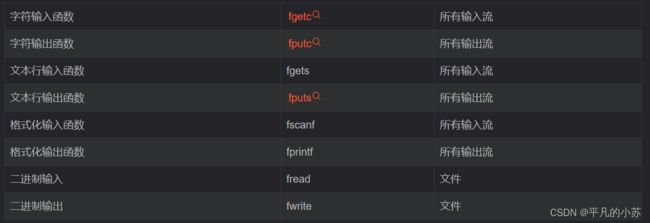【C语言】文件相关函数详解
个人主页:平凡的小苏
学习格言:别人可以拷贝我的模式,但不能拷贝我不断往前的激情
C语言专栏:https://blog.csdn.net/vhhhbb/category_12174730.html
小苏希望大家能从这篇文章中收获到许多,如果大家觉得这篇文章对你有帮助,请给小苏点赞+收藏+评论
目录
1. 为什么使用文件
2. 什么是文件
2.1 程序文件
2.2 数据文件
2.3 文件名
3. 文件的打开和关闭
3.1 文件指针
3.2 文件的打开和关闭
4. 文件的顺序读写
4.1 使用fputc和fgetc写入/读取单个字符
4.2 使用fputs和fgets写入/读取一串字符
4.3 使用fprintf和fscanf按照指定的格式写入/读取
4.4 使用fwrite和fread按照二进制的方式写入/读取
4.5 使用sprintf和sscanf将格式化数据和字符串互相转换(文件无关)
5、文件的随机读写
5.1 fseek(指定文件指针的位置)
5.2 ftell(求文件指针与起始位置的偏移量)
5.3 rewind(让文件指针回到起始位置)
6. 文本文件和二进制文件
7. 文件读取结束的判定
7.1 被错误使用的feof
8、文件缓冲区
1. 为什么使用文件
- 我们前面学习结构体时,写了通讯录的程序,当通讯录运行起来的时候,可以给通讯录中增加、删除数据,此时数据是存放在内存中,当程序退出的时候,通讯录中的数据自然就不存在了,等下次运行通讯录程序的时候,数据又得重新录入,如果使用这样的通讯录就很难受。
- 我们在想既然是通讯录就应该把信息记录下来,只有我们自己选择删除数据的时候,数据才不复存在。
- 这就涉及到了数据持久化的问题,我们一般数据持久化的方法有,把数据存放在磁盘文件、存放到数据库等方式。
- 使用文件我们可以将数据直接存放在电脑的硬盘上,做到了数据的持久化。
2. 什么是文件
- 磁盘上的文件是文件。
- 但是在程序设计中,我们一般谈的文件有两种:程序文件、数据文件(从文件功能的角度来分类的)。
2.1 程序文件
包括源程序文件(后缀为.c),目标文件(windows环境后缀为.obj),可执行程序(windows环境后缀为.exe)。
2.2 数据文件
文件的内容不一定是程序,而是程序运行时读写的数据,比如程序运行需要从中读取数据的文件,或者输出内容的文件。
2.3 文件名
3. 文件的打开和关闭
3.1 文件指针
缓冲文件系统中,关键的概念是 “ 文件类型指针 ” ,简称 “ 文件指针 ” 。
- 每个被使用的文件都在内存中开辟了一个相应的文件信息区,用来存放文件的相关信息(如文件的名字,文件状态及文件当前的位置等)。这些信息是保存在一个结构体变量中的。该结构体类型是有系统声明的,取名FILE.
struct _iobuf {
char *_ptr;
int _cnt;
char *_base;
int _flag;
int _file;
int _charbuf;
int _bufsiz;
char *_tmpfname;
};
typedef struct _iobuf FILE;
- 不同的C编译器的FILE类型包含的内容不完全相同,但是大同小异。
- 每当打开一个文件的时候,系统会根据文件的情况自动创建一个FILE结构的变量,并填充其中的信息,使用者不必关心细节。
- 一般都是通过一个FILE的指针来维护这个FILE结构的变量,这样使用起来更加方便。
下面我们可以创建一个FILE*的指针变量:
FILE* pf;//文件指针变量  3.2 文件的打开和关闭
3.2 文件的打开和关闭
文件在读写之前应该先 打开文件 ,在使用结束之后应该 关闭文件 。在编写程序的时候,在打开文件的同时,都会返回一个 FILE* 的指针变量指向该文件,也相当于建立了指针和文件的关系。ANSIC 规定使用 fopen 函数来打开文件, fclose 来关闭文件
//打开文件
FILE * fopen ( const char * filename, const char * mode );//filename指打开的文件名,mode指打开的文件方式
//关闭文件
int fclose ( FILE * stream );
stream是文件指针,文件使用完后一定要fclose关闭,并把文件指针置空。(用起来像free)实例代码:
int main()
{
FILE* pf = fopen("test.txt", "r");//文件路径可以是相对路径或绝对路径
if (pf == NULL)
{
printf("%s\n", strerror(errno));
exit(-1);
}
fclose(pf);//不关闭文件可能会造成数据丢失
pf = NULL;
return 0;
}
4. 文件的顺序读写
4.1 使用fputc和fgetc写入/读取单个字符
注:这里是利用wplusplus查的参数类型
- 写入单个字符到文件
- character:要写入的字符
- stream:指向输出流 FILE 对象的指针。
示例代码:
int main()
{
FILE* pf = fopen("test.txt", "w");//文件路径可以是相对路径或绝对路径
if (pf == NULL)
{
printf("%s\n", strerror(errno));
//perror("fopen");//void perror ( const char * str )用来将上一个函数发生错误的原因输出到标准设备(stderr)
exit(-1);
}
for (char i = 'a'; i <= 'z'; i++)
{
fputc(i, pf);//输出
}
fclose(pf);
pf = NULL;
}
- 读取文件中的单个字符
- stream:指向输入流 FILE 对象的指针。
int main()
{
pf = fopen("test.txt", "r");//文件路径可以是相对路径或绝对路径
if (pf == NULL)
{
printf("%s\n", strerror(errno));
exit(-1);
}
printf("%c\n", fgetc(pf));//输入,也可以写一个循环读取
printf("%c\n", fgetc(pf));
printf("%c\n", fgetc(pf));
printf("%c\n", fgetc(pf));
printf("%c\n", fgetc(pf));
fclose(pf);
pf = NULL;
return 0;
}4.2 使用fputs和fgets写入/读取一串字符
- 写入一串字符到文件
- str:要写入的字符串的地址
- stream:指向输出流 FILE 对象的指针。
代码示例:
int main()
{
FILE* pf = fopen("test.txt", "w");
if (pf == NULL)
{
perror("fopen:");
exit(-1);
}
char arr[] = "abcde";//test.txt文件被写入abcde
fputs(arr, pf);
fclose(pf);
pf = NULL;
return 0;
}
- 读取文件中num个字符
- str:读到的字符串放到str指向的空间里去
- num:读取num-1个字符,并补上\0
- stream:指向输入流 FILE 对象的指针。
- 读取成功:返回str的地址
- 读取失败或错误:返回空指针
代码示例:
从下图可以看出,读取num-1个字符最后一个补上斜杠零
4.3 使用fprintf和fscanf按照指定的格式写入/读取
- stream:指向输出流 FILE 对象的指针。
- 后续参数使用方法与printf一样
代码示例:
struct S
{
char name[20];
int tele;
float scores;
};
int main()
{
struct S s = { "zhangsan",1510,66.5f };
FILE* pf = fopen("test.txt", "w");
if (pf == NULL)
{
perror("fopen:");
exit(-1);
}
fprintf(pf, "%s %d %f", s.name, s.tele, s.scores);//打印到txt文件
fprintf(stdout, "%s %d %f", s.name, s.tele, s.scores);//打印到屏幕
fclose(pf);
pf = NULL;
return 0;
}stdout是标准化输出,使它与使用printf一样,而不是写入文件里面中去
- stream:指向输入流 FILE 对象的指针。
- 后续参数使用方法和scanf一样
- 后面的省略号指可变参数列表
代码示例:
struct S
{
char name[20];
int tele;
float scores;
};
int main()
{
struct S s = { 0 };
FILE* pf = fopen("test.txt", "r");
if (pf == NULL)
{
perror("fopen:");
exit(-1);
}
fscanf(pf, "%s %d %f", s.name, &s.tele, &s.scores);//将文件中的内容读取到结构体中
printf("%s %d %f", s.name, s.tele, s.scores);
fclose(pf);
pf = NULL;
return 0;
}4.4 使用fwrite和fread按照二进制的方式写入/读取
- ptr:从ptr指向的当前位置开始写入
- size:每个元素的大小
- count:要写入的元素个数
- stream:指向输出流 FILE 对象的指针。
struct S
{
char name[20];
int age;
float score;
};
int main()
{
struct S s = { "张三", 20, 98.5};
FILE* pf = fopen("text.txt", "wb");
if (NULL == pf)
{
perror("fopen");
return 1;
}
//写文件
fwrite(&s, sizeof(struct S), 1, pf);
//关闭文件
fclose(pf);
pf = NULL;
return 0;
}
- fread参数和fwrite一样
- ptr:从ptr指向的当前位置开始读取
代码示例:
struct S
{
char name[20];
int age;
float score;
};
//测试二进制的写函数:fread
int main()
{
struct S s = { 0};
FILE* pf = fopen("test.txt", "rb");
if (NULL == pf)
{
perror("fopen");
return 1;
}
//读文件
fread(&s, sizeof(struct S), 1, pf);
printf("%s %d %f\n", s.name, s.age, s.score);
//关闭文件
fclose(pf);
pf = NULL;
return 0;
}fread读取成功或者失败的返回值文档描述
返回成功读取的元素总数。
如果这个数字与count参数不同,则要么发生了读取错误,要么在读取时到达了文件末尾。在这两种情况下,都设置了正确的指示器,可以分别使用ferror和feof进行检查。
如果size或count中有一个为零,函数返回零,流状态和ptr指向的内容都保持不变。
Size_t是无符号整型
4.5 使用sprintf和sscanf将格式化数据和字符串互相转换(文件无关)
- 将格式化数据转换为字符串
- str:将格式化数据放到目标地址
- 后续参数和使用方式和printf一样
struct S
{
char name[20];
int tele;
float scores;
};
int main()
{
struct S s = { "zhangsan",1510,66.5f };
char arr[60]={0};
sprintf(arr, "%s %d %f", s.name, s.tele, s.scores);
printf("%s", arr);
return 0;
}
- 将字符串转换为格式化数据
- s:指向字符串的指针
- 后续参数和使用方式和scanf一样
struct S
{
char name[20];
int tele;
float scores;
};
int main()
{
struct S s = { 0 };
char arr[60]={ "zhangsan 1510 66.5f" };
sscanf(arr, "%s %d %f", s.name, &s.tele,&s.scores);
printf("%s %d %f", s.name,s.tele,s.scores );
return 0;
}5、文件的随机读写
5.1 fseek(指定文件指针的位置)
注意:每次文件读取完毕后,文件指针++
- stream:指向标识流的 FILE 对象的指针
- offset:指针偏移量
- origin:指针起始点
如下表:
| SEEK_SET | 文件开头 |
| SEEK_CUR | 文件指针当前所处的位置 |
| SEEK_END | 文件结尾 |
代码示例:
int main()
{
FILE* pf = fopen("test.txt", "r+");
if (pf == NULL)
{
perror("fopen:");
exit(-1);
}
fputs("abcde", pf);
fseek(pf, 2, SEEK_SET);
int ch = fgetc(pf);//该语句执行完毕后,指针++,指向d
printf("%c ", ch);//打印c
fseek(pf, 0, SEEK_CUR);
ch = fgetc(pf); //该语句执行完毕后,指针++,指向e
printf("%c ", ch);//打印d
fseek(pf, -1, SEEK_END);//这里SEEK_END是指向e的后一个
ch = fgetc(pf);//该语句执行完毕后,指针++,指向e的后一个
printf("%c ", ch);//打印e
fclose(pf);
pf = NULL;
return 0;
}5.2 ftell(求文件指针与起始位置的偏移量)
代码示例:
int main()
{
FILE* pf = fopen("test.txt", "r+");
if (pf == NULL)
{
perror("fopen:");
exit(-1);
}
fputs("abcde", pf);
fseek(pf, -1, SEEK_END);//这里SEEK_END是指向e的后一个
int ch = fgetc(pf);//该语句执行完毕后,指针++,指向e的后一个
printf("%c ", ch);//打印e
printf("%d", ftell(pf));//打印5,当前指针在e的后一个,相对于a相差5
fclose(pf);
pf = NULL;
return 0;
}5.3 rewind(让文件指针回到起始位置)
6. 文本文件和二进制文件
根据数据的组织形式,数据文件被称为 文本文件 或者 二进制文件 。数据在内存中以二进制的形式存储,如果不加转换的输出到外存,就是 二进制文件 。如果要求在外存上以 ASCII 码的形式存储,则需要在存储前转换。以 ASCII 字符的形式存储的文件就是 文 本文件 。
7. 文件读取结束的判定
7.1 被错误使用的feof
牢记:在文件读取过程中,不能用 feof 函数的返回值直接用来判断文件的是否结束。而是 应用于当文件读取结束的时候,判断是读取失败结束,还是遇到文件尾结束 。1. 文本文件读取是否结束,判断返回值是否为 EOF ( fgetc ),或者 NULL ( fgets )例如:fgetc 判断是否为 EOF .fgets 判断返回值是否为 NULL .2. 二进制文件的读取结束判断,判断返回值是否小于实际要读的个数。例如:fread 判断返回值是否小于实际要读的个数。
二进制文件的例子:
#include
enum { SIZE = 5 };
int main(void)
{
double a[SIZE] = {1.,2.,3.,4.,5.};
FILE *fp = fopen("text.txt", "wb"); // 必须用二进制模式
fwrite(a, sizeof *a, SIZE, fp); // 写 double 的数组
fclose(fp);
double b[SIZE];
fp = fopen("test.bin","rb");
size_t ret_code = fread(b, sizeof *b, SIZE, fp); // 读 double 的数组
if(ret_code == SIZE) {
puts("Array read successfully, contents: ");
for(int n = 0; n < SIZE; ++n) printf("%f ", b[n]);
putchar('\n');
} else { // error handling
if (feof(fp))
printf("Error reading test.bin: unexpected end of file\n");
else if (ferror(fp)) {
perror("Error reading test.bin");
}
}
fclose(fp);
} 8、文件缓冲区
- ANSIC 标准采用“缓冲文件系统”处理的数据文件的,所谓缓冲文件系统是指系统自动地在内存中为程序中每一个正在使用的文件开辟一块“文件缓冲区”。
- 从内存向磁盘输出数据会先送到内存中的缓冲区,装满缓冲区后才一起送到磁盘上。
- 如果从磁盘向计算机读入数据,则从磁盘文件中读取数据输入到内存缓冲区(充满缓冲区),然后再从缓冲区逐个地将数据送到程序数据区(程序变量等)。缓冲区的大小根据C编译系统决定的。
好了!小编的分享到这里就结束了,如果有什么不足的地 方,请各位大佬多多指教!!!

















